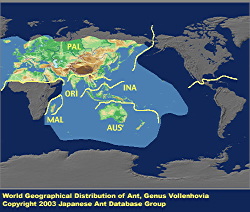
|
genus
|
Vollenhovia
|
 |

|
|
Japanese Name
|
Umematsu-ari-zoku
|
Original Reference
|
|
Mayr, G. (1865) Reise der …sterreichischen Fregatte Novara um die Erde in den Jahren 1857, 1858, 1859, unter den befehlen des Commodore B. von WŸllerstorf-Urbair. Zoologischer Theil. Formicidae: 119 pp. Wien.
|
Description
|
|
Total length of workers around 2 - 6 mm. Body color yellow to blackish brown. Mandibles triangular, each with 4 to 7 teeth. Palpal formula 2:2. Clypeus with a pair of longitudinal carinae. Frontal carinae short, frontal lobes small. Antennae usually 12- segmented (11- segmented in some species); the three apical segments forming a club. Scapes short, not reaching occipital border of head. Eyes developed. Promesonotal area depressed, almost straight in profile. Metanotal groove varying from feeble to distinct. Posterior border of propodeum rounded or with a pair of blunt processes. Petiolar peduncle either lacking or very short; posterior border of petiole marginate, defining a distinct gap between petiole and postpetiole. Petiole usually with a large, vertically lamellate subpetiolar process. Legs relatively short. Middle and hind legs lacking tibial spurs.
|
|

|
Remarks
|
|
Ettershank (1966) excluded this genus from the tribe Solenopsidini where it had been previously placed, but did not assign it to another tribe. Wheeler & Wheeler (1985) and Hoelldobler & Wilson (1990) retained it in the Solenopsidini. Recently Bolton (1994) placed this genus in the Metaponini. About 50 named Vollenhovia species are known from SE Asia (India and eastward), New Guinea, Australia and Oceania. Most species have monomorphic workers, but in some the workers are polymorphic. Some have ergatoid females. Although the biology of this genus is poorly known, the workers of at least some species are predators of insect larvae. Most species nest in decaying wood or under bark in forests. Although only one species was nominated in "A List of the Ants of Japan with Common Japanese Names" (Myrmecological Society of Japan Editorial Committee, 1988), we recognize 7 species from Japan. V. nipponica is a social parasite, and lacking a worker caste. Teranishi (1933) reported V. emeryi chosenenica from Japan, but there have been no subsequent records. We exclude it from consideration here.
|
References
|
|
- Etterschank, G. (1966). A generic revision of the world Myrmicinae related to Solenopsis and Pheidologeton (Hymenoptera: Formicidae). . Aust. J. Zool. , 14, 73-171.
- Wheeler, G. C. & J. Wheeler (1985). A simplified conspectus of the Formicidae. . Trans. Am. Ent. Soc., 111, 255-264.
- Hoelldobler, B. & E. O. Wilson (1990). The ants. . , 732.
- Myrmecological Society of Japan, Editorial Committee (ed.) (Ed.). (1988). A list of the ants of Japan with common Japanese names. The Myrmecological Society of Japan, Tokyo.
- Kinomura, K. & K. Yamauchi (1992). A new workerless socially parasitic species of the genus Vollenhovia (Hymenoptera, Formicidae) from Japan. . Jpn. J. Ent., 60, 203-206.
- Teranishi, C. (1933). Japanese ants, their behavior and distribution (III). . Trans. Kansai Ent. Soc., (4, 77-80. .
- Reise der …sterreichischen Fregatte Novara um die Erde in den Jahren 1857, 1858, 1859, unter den befehlen des Commodore B. von WŸllerstorf-Urbair. Zoologischer Theil. Formicidae: 119 pp. Wien.
- Bolton, B. (1994). Identification guide to the ant genera of the world. Harvard University Press, 222 pp.
|
Editor
|
|
Original text by Mamoru Terayama and Katsusuke Yamauchi. English translation by Mamoru
Terayama, edited by Robert W. Taylor.
|
|